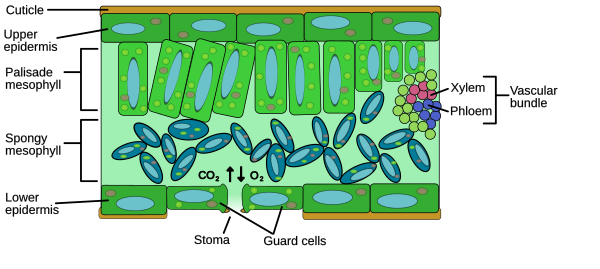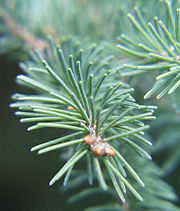Leaf anatomy
A structurally complete leaf of an angiosperm consists of a petiole (leaf stem), a lamina (leaf blade), and stipules (small processes located to either side of the base of the petiole). The petiole attaches to the stem at a point called the "leaf axil." Not every species produces leaves with all of the aforementioned structural components. In some species, paired stipules are not obvious or are absent altogether. A petiole may be absent, or the blade may not be laminar (flattened). The tremendous variety shown in leaf structure (anatomy) from species to species is presented in detail below under Leaf morphology. After a period of time (i.e. seasonally, during the autumn), deciduous trees shed their leaves. These leaves then decompose into the soil.
A leaf is considered a plant organ and typically consists of the following tissues:
- An epidermis that covers the upper and lower surfaces
- An interior chlorenchyma called the mesophyll
- An arrangement of veins (the vascular tissue)
[edit]Epidermis
The epidermis is the outer layer of cells covering the leaf. It forms the boundary separating the plant's inner cells from the external world. The epidermis serves several functions: protection against water loss, regulation of gas exchange, secretion of metabolic compounds, and (in some species) absorption of water. Most leaves show dorsoventral anatomy: the upper (adaxial) and lower (abaxial) surfaces have somewhat different construction and may serve different functions.
The epidermis is usually transparent (epidermal cells lack chloroplasts) and coated on the outer side with a waxy cuticle that prevents water loss. The cuticle is in some cases thinner on the lower epidermis than on the upper epidermis, and is thicker on leaves from dry climates as compared with those from wet climates.
The epidermis tissue includes several differentiated cell types: epidermal cells, guard cells, subsidiary cells, and epidermal hairs (trichomes). The epidermal cells are the most numerous, largest, and least specialized. These are typically more elongated in the leaves of monocots than in those of dicots.
The epidermis is covered with pores called stomata, part of a stoma complex consisting of a pore surrounded on each side by chloroplast-containing guard cells, and two to four subsidiary cells that lack chloroplasts. The stoma complex regulates the exchange of gases and water vapor between the outside air and the interior of the leaf. Typically, the stomata are more numerous over the abaxial (lower) epidermis than the adaxial (upper) epidermis.
[edit]Mesophyll
Most of the interior of the leaf between the upper and lower layers of epidermis is a parenchyma (ground tissue) or chlorenchyma tissue called themesophyll (Greek for "middle leaf"). This assimilation tissue is the primary location of photosynthesis in the plant. The products of photosynthesis are called "assimilates".
In ferns and most flowering plants the mesophyll is divided into two layers:
- An upper palisade layer of tightly packed, vertically elongated cells, one to two cells thick, directly beneath the adaxial epidermis. Its cells contain many more chloroplasts than the spongy layer. These long cylindrical cells are regularly arranged in one to five rows. Cylindrical cells, with the chloroplasts close to the walls of the cell, can take optimal advantage of light. The slight separation of the cells provides maximumabsorption of carbon dioxide. This separation must be minimal to afford capillary action for water distribution. In order to adapt to their different environment (such as sun or shade), plants had to adapt this structure to obtain optimal result. Sun leaves have a multi-layered palisade layer, while shade leaves or older leaves closer to the soil, are single-layered.
- Beneath the palisade layer is the spongy layer. The cells of the spongy layer are more rounded and not so tightly packed. There are large intercellular air spaces. These cells contain fewer chloroplasts than those of the palisade layer.
The pores or stomata of the epidermis open into substomatal chambers, connecting to air spaces between the spongy layer cells.
These two different layers of the mesophyll are absent in many aquatic and marsh plants. Even an epidermis and a mesophyll may be lacking. Instead for their gaseous exchanges they use a homogeneous aerenchyma (thin-walled cells separated by large gas-filled spaces). Their stomata are situated at the upper surface.
Leaves are normally green in color, which comes from chlorophyll found in plastids in the chlorenchyma cells. Plants that lack chlorophyll cannotphotosynthesize.
Leaves in temperate, boreal, and seasonally dry zones may be seasonally deciduous (falling off or dying for the inclement season). This mechanism to shed leaves is called abscission. After the leaf is shed, a leaf scar develops on the twig. In cold autumns they sometimes change color, and turn yellow, bright orange or red as various accessory pigments (carotenoids and xanthophylls) are revealed when the tree responds to cold and reduced sunlight by curtailing chlorophyll production. Red anthocyanin pigments are now thought to be produced in the leaf as it dies, possibly to mask the yellow hue left when the chlorophyll is lost - yellow leaves appear to attract herbivores such as aphids.[1]
[edit]Veins
The veins are the vascular tissue of the leaf and are located in the spongy layer of the mesophyll. They are typical examples of pattern formationthrough ramification. The pattern of the veins is called venation.
The veins are made up of:
- Xylem: tubes that brings water and minerals from the roots into the leaf.
- Phloem: tubes that usually move sap, with dissolved sucrose, produced by photosynthesis in the leaf, out of the leaf.
The xylem typically lies over the phloem. Both are embedded in a dense parenchyma tissue, called "pith", with usually some structural collenchyma tissue present.
[edit]Leaf morphology
External leaf characteristics (such as shape, margin, hairs, etc.) are important for identifying plant species, and botanists have developed a richterminology for describing leaf characteristics. These structures are a part of what makes leaves determinant; they grow and achieve a specific pattern and shape, then stop. Other plant parts like stems or roots are non-determinant, and will usually continue to grow as long as they have the resources to do so.
Classification of leaves can occur through many different designative schema, and the type of leaf is usually characteristic of a species, although some species produce more than one type of leaf. The longest type of leaf is a leaf from palm trees, measuring at nine feet long. The terminology associated with the description of leaf morphology is presented, in illustrated form, at Wikibooks.
[edit]Basic leaf types
- Ferns have fronds
- Conifer leaves are typically needle-, awl-, or scale-shaped
- Angiosperm (flowering plant) leaves: the standard form includes stipules, a petiole, and a lamina
- Lycophytes have microphyll leaves.
- Sheath leaves (type found in most grasses)
- Other specialized leaves (such as those of Nepenthes)











